by Celeste Lipford and Terry Lipford - last updated on 8/27/2025
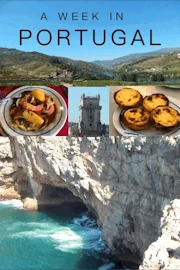
This was our third major "target" for our week in Portugal; We had heard stories from Celeste's parents about how beautiful the Algarve is, and how good the food was, so our expectations were high and our zeal to start our exploration there was at a high level!
The Algarve region of Portugal is a stunning destination known for its golden beaches, dramatic cliffs, and picturesque fishing villages. We were drawn to its beautiful coastline, where we could explore secluded coves, relax on pristine beaches, or enjoy watersports like surfing and kayaking. The area also offers charming historic towns like Lagos and Tavira, rich with culture and history. Its warm Mediterranean climate, delicious seafood, and vibrant nightlife make the Algarve an ideal spot for both relaxation and adventure, and we were excited to be heading there!
Our use of the word "target" was meant to point out that we had spent time in Northern Portugal in the Douro Valley, and a week in the Lisbon area exploring Lisbon, Caiscais and everthing in between. Driving to the Algarve and exploring that area, would allow us to round out our Portugal adventure.
Our road trip from Lisbon to the Algarve would be a 2.5 – 3 hour journey through scenic landscapes, including rolling hills, cork forests and olive groves. Upon arrival, we planned to enjoy the Algarve’s golden cliffs, turquoise waters, and charming villages like Lagos and Albufeira, perfect for exploring beaches and savoring fresh seafood.
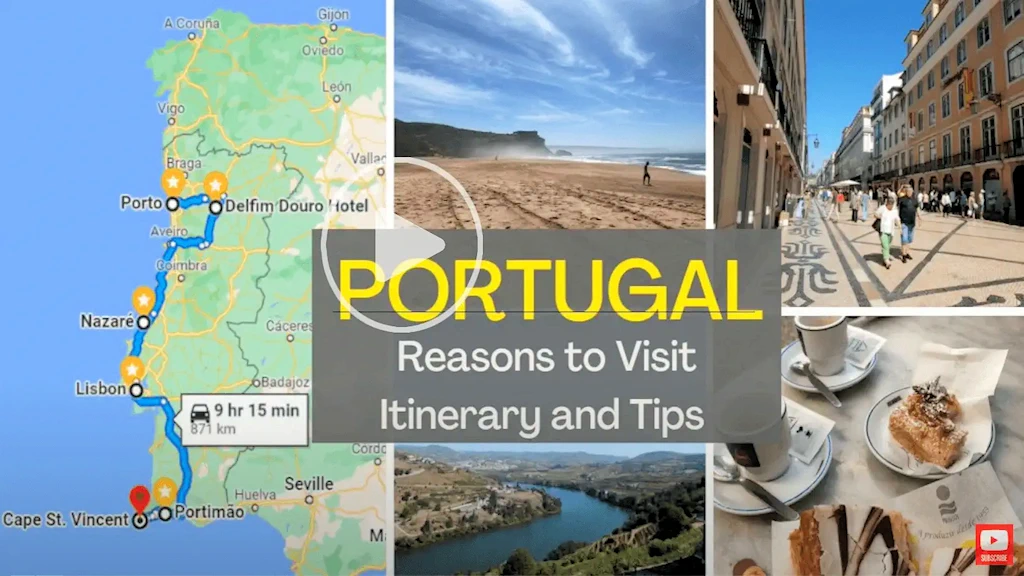
NOTE: This video is the property of Just Traveling Thru, LLC.
If you enjoy our videos click here to subscribe to our Youtube Channel.
Click the above video poster image to explore our Portugal Reasons to Visit and Travel Vlog - In this Portugal vacation travel video guide we'll provide reasons to visit and information about how to spend a week in Portugal. Portugal is a beautiful country directly on the Atlantic Ocean that offers a lot of value for your money and it has a fascinating history and culture. From the Douro River Valley to Nazare surf beach to the scenic and historic Lisbon and then south to the incredibly picturesque beaches of the Algarve Portugal has a lot to offer.
Departing our Lisbon Condo: Our condo was located near the intersection of Calçada Galvão and R. Gen. João de Almeida which is pretty much suburbia north of the Jeronimo Monastery. After packing up our rental car, we drove north on the Calçada Galvão to where we could access the A5 and then merged onto the A2 to get to the 25th of April Bridge. Click here to view a larger Google Map of our route.
Getting There: The freeway from Lisbon to Portimão was easy to navigate and had very little traffic. We stayed on the A2 until it became the E2. Leaving the E2 onto Portugal A22 to Portimão, exited onto the N124 to enter Portimão. As the Tivoli Hotel & Marina was perhaps 10 miles away, we traversed Portimão on local streets with numerous round-a-bouts and traffic. Typical for Europe, but a little challenging for many Americans! Diligence & discipline in driving & navigation is required !
Highway Services: Once you pass over the 25th of April Bridge and proceed south on the A2, there is a lot of wide open space and very few villages or cities. Rolling hills, cork trees, and the occasional cow or horse, but not much else! You should use Google Maps (or the map service of your choice) to locate where gas stations can be found on this highway.
Maps or Mapping App: Keep them out and have it displaying your route, because the Portimão city streets are narrow, frequent round-abouts & crowded with lots of traffic!
How far is Algarve from Lisbon: The driving distance from Lisbon to our Algarve Hotel was slightly over 300 kilometers.
The top 5 accommodations in Portimão based upon the highest guest ratings (according to Google), include these standout options:
If you would like to perform your own accommodations research, click here to view a Google Search Results list for "accommodations in Portimão".
In the next section of this page, we will show you the accommodation selection we made.
We should explain that we did not rent from the NH Marina Portimão Resort Hotel, we rented a two story large suite from VRBO. As you can see in our images, we had all the advantages of a hotel (including parking, restaurant & pub) but we had use of a very nice suite that included a private top floor BBQ and sunbathing area for our unit only. If you are ever in this area, we would encourage you to consider looking at this VRBO rental, as we found it to be very nice.
These above images are views of the Hotel Pool area from the top floor of our apartment (the top floor is a private deck for our condo rental). As you can easily see, the pool is quite large (not deep though) and there were a number of lounges & tables for everyone to utilize.
The Tivoli is a very comfortable hotel; huge pool, nice outside cabana area for drinks & snacks and a good restaurant. The Praia da Rocha is perhaps 100 meters away, just past the Marina and a row of restaurants. The Hotel restaurant and snack bar are in the center of this image, adjacent to the Arade River.
Image #1 provides an excellent perspective on just how well-situated our apartment was. The Tivoli Marina and Hotel, prominently located in the lower center of the image, is perfectly positioned amidst the picturesque Tivoli Marina. Its prime location made it a breeze to explore the surrounding area, with the city of Portimão and the beautiful beaches just a short and pleasant walk away. The view showcases the seamless blend of vibrant city life and serene coastal beauty.
Image #2 captures the main entrance of the hotel, a sleek and welcoming entry point conveniently located next to the hotel’s parking area. This thoughtful design ensures easy access for guests arriving by car, making the first impression both practical and inviting.
The Praia da Rocha beach, visible at the top right of image # 1, offers an expansive stretch of golden sands and turquoise waters, while the charming city of Portimão lies to the right, adding to the area's appeal.
Our journey to the hotel was an adventure in itself. Without the expert navigation skills of Celeste and the indispensable Google Maps app on our phones, we might still be wandering the scenic streets of Portugal, endlessly charmed but hopelessly lost. This trip was a delightful mix of exploration, discovery, and stunning coastal escapes.
Both images above are the property of the Tivoli Marina Portimao Algarve Resort via their Website. All other images are the property of Just Traveling Thru, LLC unless otherwise noted.
The Algarve, Portugal's southernmost region, offers a diverse array of attractions. Here are five top recommendations (please note that the attractions are linked to a Google Map for your convenience):)
How to get to Portimão from Lisbon?
There are numerous transportation options available;
What is the best time of year to visit Portimão?
The best time to visit Portimao is during the late spring and early summer months, specifically from late May to mid-September, as this period offers pleasant weather with warm temperatures, minimal rainfall, and ideal conditions for beach activities while avoiding the peak crowds of high summer.
Is Portugal a safe place to visit?
According to recent data, Portugal has a relatively low crime index compared to other European countries, with a score often listed around 31.2, ranking it as one of the safer nations in Europe; this means that overall, crime rates in Portugal are considered low compared to the European average. The Portimão crime rate index is 19.41 in comparison.
What are the seasonal temperature ranges for Portimão?
The warm season lasts for 3.0 months, from June 19 to September 20, with an average daily high temperature above 77°F. The hottest month of the year in Portimão is August, with an average high of 80°F and low of 66°F.
The cool season lasts for 3.7 months, from November 23 to March 15, with an average daily high temperature below 64°F. The coldest month of the year in Portimão is January, with an average low of 48°F and high of 60°F.
Is Praia da Rocha safe to swim in?
Yes, the ocean at Portimão, Portugal is generally considered clean and good for swimming, particularly at beaches like Praia da Rocha, thanks to calm waters and regular monitoring of water quality; however, always check local conditions and flag warnings before entering the water.
There is a flag system on the beaches to let tourists know if the water is safe or if the beach is supervised. A red flag signals that you should stay out of the water completely. A yellow flag means swimming is not advised, but paddling is allowed. Green flags mean that it's time to swim.
Is tap water safe to drink in Portimão?
Yes, it's generally safe and healthy to drink the public tap water across Portugal.
Will I need a car in Portimão?
Yes, renting a car in Portimão is a good way to explore the area and nearby attractions. Portimão has many things to see and do, and a car gives you the flexibility to drive to nearby cities and/or interesting sites.
Local Portimão buses are available, but they can be infrequent, especially on weekends and holidays. The VAMUS bus 56, also known as Aerobus, runs directly from Faro Airport to Portimão. uBer and local taxis are also available.
In Portugal, life revolves around coffee. People drink it from first thing in the morning and often right up until late evening — it's not uncommon for people to finish a meal at 10 or 11 pm and have a coffee after. In Portimão, coffee is commonly paired with a pastry, particularly in the morning. The iconic pairing is bica with a pastel de nata, the famous Portuguese custard tart. Many locals stop by their neighborhood café for a quick bica and a pastry before starting their day.
The most common way to enjoy coffee in Portimão is by ordering a "uma bica" (also known as "um café"), which is similar to an espresso. It’s a small, strong, and slightly bitter shot of coffee, often served with sugar on the side. Locals drink uma bicas throughout the day, particularly after meals or during quick breaks.
There are a variety of coffee drinks other than the uma bica;
Coffee is more than just a drink in Portugal; it's a ritual. Many people have their favorite café that they visit regularly, often at the same time each day. This sense of routine adds to the importance of coffee in everyday life.
Click here to view a Google Map displaying "coffee shops in Portimão". For reference purposes, a coffee shop is called a "Pastelarias" in Portuguese.
Portuguese Pastries
Some of the best Portuguese pastries to enjoy with coffee include the iconic Pastel de Nata, a creamy custard tart, and the fluffy Pão de Deus, a coconut-topped sweet bread. Other popular choices are Bolo de Bolacha, a biscuit cake; Bolo de Arroz, a sweet rice muffin; and Travesseiros de Sintra, puff pastry pillows filled with almond.
Praia da Rocha is one of the Algarve’s most stunning beaches. This expansive stretch of golden sand is framed by dramatic cliffs and unique rock formations that create a striking contrast against the turquoise waters. The beach offers something for everyone: sunbathing on the soft sand, exploring the caves and arches along the coastline, or enjoying water sports like paddleboarding and jet skiing. A scenic boardwalk lined with restaurants, cafes, and bars overlooks the beach, making it easy to grab a meal or a refreshing drink while taking in the view. Nearby, the 17th-century Santa Catarina Fortress provides a dose of history and panoramic views of the coastline.
The city of Portimão is off to the left in image # 1, and the Tivoli Marina where we were staying is at the far eastern end of this beach view. The entry to the Arade River can be seen in the top center of this image.
Image # 1 was taken from the top of the Viewpoint of the Three Castles ("Miradouro dos Três Castelos") on an early morning hike we took. As you can see, there are very few people on the beach, that will change as the day progresses.
Image # 2 is looking westward from a lookout point on Viewpoint of the Three Castle (Avenue Tomas Cabreira of Tres Castelos beach). You can see all of the beach chairs and lounges ready to be rented!
Image # 3 was taken from the other side of the rocks, where we descended to the beach to find a spot where we could play paddle ball, and were amazed at the cliff rock formations.
In image # 4 the rock formations & cliff on the west end of Praia da Rocha beach, you can see how small the people are in relation to the cliff. We took this picture early in the day, and the beach crowd had not yet started to arrive. After we spread our towels out and hung out for a while, the crowds were starting to build up.
Image # 1: This is one way you can get from Tres Castelos beach to Praia da Rocha beach! At low tide you can just walk around through the water. Speaking from experience, that particular cave was just barely tall enough for me to squeeze through.
Image # 2: Looking back at Portimão from a lookout point above Tres Castelos beach. See the boardwalk in the center of this picture? There are a number of small restaurants & pubs all along this walkway. Because of their proximity to the Atlantic Ocean, each establishment offers really nice views of the beach & the water.
Image # 3: You can see in this picture that the beach is not yet crowded, this is because it was still early in the morning and the crowd would not begin to arrive for another hour.
This was a 65 kilometer day trip drive from our hotel in Portimão, giving us sufficient time to explore along the way. Our goal was to explore the Sagres Fortress, Farol do Cabo de São Vicente and whatever else we might run across that looked interesting.
Not sure if you can see them or not, but local surfers are out there in a large group in the right center of the above picture.
Praia do Beliche is a very popular surfer destination in the Cape St. Vincent area. This is one of Sagres' best surf beaches with the waves often a little more manageable than at the other beaches around the headland. The 40 metre high cliffs also provide some shelter from the winds that Sagres is notorious for.
The motivation for us to drive here, comes in two parts, ie; This was where Prince Henry the Navigator built his school of navigation in the 15th century. Part two is that the cliffs in this area are fantastic, and the waves coming in from the Atlantic will frequently be massive.
Beside the historical signficance of the Sagres area, the drive takes you through a larger part of the Algarve area - taking you into pretty villages, amazing coastline and then you arrive at the farthest southwest point in Europe!
Take a look at the map link above; we first drove to the Fontaleza de Sagres, and explored there first. We then drove over to the Lighthouse of Cabo de São Vicente and explored there.
We were standing in the Sagres Fortress area, looking over at the next peninsula which has a lighthouse on it (images # 1 & 2). That lighthouse was built in 1846 and was constructed on the old ruins of a Franciscan monastery. It now belongs to the Portuguese Navy. The lighthouse is the second most powerful in Europe (after Phare du Creach in Brittany) and the light beam can be seen 60 kilometers away.
The cliffs in the Sagres area are astounding, and the Atlantic Ocean pounds away at them constantly. Cliff heights here can reach 75 meters! As is usual in Europe, there are no walls or signs telling you to stay away from the cliff edges, Europe expects you to be smart enough to already know that!
NOTE: Image # 1 (the large image above) is the property of Dr.G.Schmitz using the CC BY-SA 3.0 license. All other images are the property of Just Traveling Thru, LLC unless otherwise noted.
You can see in this picture how the Ocean has pounded out a cave in the cliff. The waves get extremely large in the winter here, for a graphic portrayal of winter storm driven waves take a look at this YouTube video. I would suggest that you have never seen waves that large, unless you have spent some time at sea!
This video is the property of The Local Truth via YouTube.
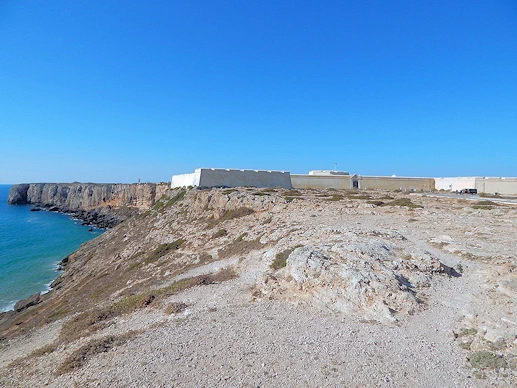
Sagres Fortress
This is the Sagres Fortress (Fortaleza Sagres). It is located at the southern tip of the Sagres Peninsula and was designed to protect the town from from North African raiders. It was from here that Henry the Navigator devised his 15th century expeditions to the uncharted seas around the western side of Africa, which heralded in the golden era of Portuguese exploration.
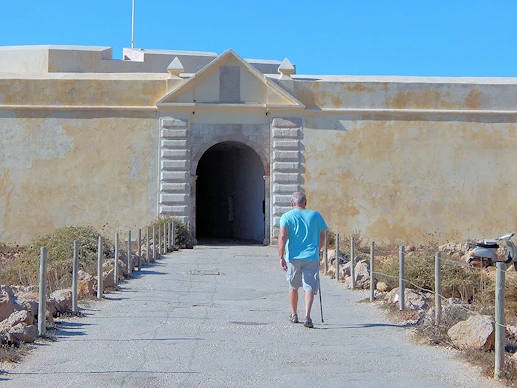
Sagres Fortress Entrance
This is the Sagres Fortress entrance area. We went in and explored the area. It is much larger inside that it would appear!
It is fascinating to realize that Prince Henry not only once taught men to navigate here, he also sponsored a number of explorations of west Africa by Portuguese sailors.
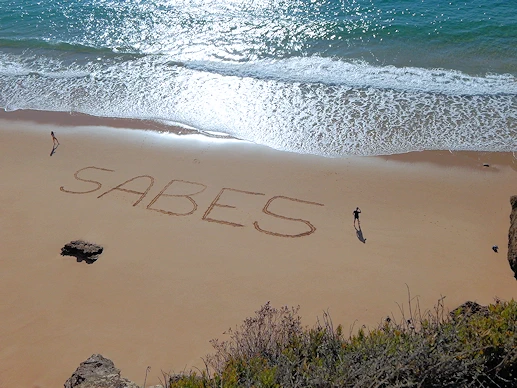
Beach below Sagres Fortress
Taken from the cliffs nearest the Sagres Fortress parking lot, some people are enjoying the beach. We could see the trail that those people had to have taken down there, and it looked like a challenging descent!
By the way, that word written in the sand translates to "you know" in English.
Portimão boasts a vibrant culinary scene with several highly rated restaurants. Here are five (as of 3/4/2025) top-rated establishments according to Google (and bear in mind that these ratings vary as people review & rate an establishment). If you would prefer to perform your own restaurant research, here is the link to a Google Search Results list for "most popular restaurants in Portimão" based upon Google Review Ratings.
This list below was sorted by "4.5+ rating or higher":
We had a great dinner at the Restaurante Almeida, located on the water front adjacent to the Tivoli Hotel where we were staying. The food there was fantastic, and the vibe of being next to the beach, with good wine, and excellent seafood, provided us with a memorable dinner experience. Note: They do not have a website, but you can find them on Google.
Special Note: If you like pastel de natas, or if you would like to try one of these amazing pastries, here is a Google Search Results link for "where are the best pastel de natas in portimao". Enjoy!
I had a cataplana (Portuguese Fish Stew); At Restaurante Almeida, the cataplana is prepared with an exquisite selection of fresh seafood, including clams, mussels, shrimp, and fish, simmered in a rich tomato and wine-based sauce. The dish often includes fragrant onions, peppers, and coriander, combining to create a hearty, flavorful broth. Each bite is a taste of Portugal’s seaside heritage, with the ingredients perfectly balanced to highlight their natural flavors.
The cozy atmosphere of Almeida, paired with the warmth of the staff, enhances the experience. A serving of crusty bread is ideal for soaking up the remaining sauce, ensuring nothing goes to waste. Whether you’re a seafood enthusiast or eager to explore Algarve’s culinary traditions, enjoying cataplana at Restaurante Almeida offers a memorable and authentic dining experience, steeped in local culture and flavors.
Praia da Marinha, Ponta da Piedade area, Praia do Camilo and Praia da Rocha.
Yes; buses are limited; easier access to cliffs/coves. As an example, the Sagres Fortress is 60 kilometers from Portimão.
Licensed boat/kayak/SUP; watch conditions; swimming is not advised
Spring/fall for weather + fewer crowds
Late spring (May–June) and early fall (September–October) offer great weather and fewer crowds compared to peak summer.
Lagos/Portimão for scenery & beaches; Tavira for charm; Albufeira for nightlife; Sagres for wild coast.
NOTE: Below are some useful links where you can find even more information about the areas we have described on this page. There are of course, many other useful websites & pages, so for something specific, we would suggest using Google Search.
Note: All images featured on this page are the exclusive property of Just Traveling Thru, LLC, unless otherwise stated. When images from external sources are used, full credit is given to the original creator, along with a link to the specified license or usage terms. We are committed to respecting copyright and intellectual property rights, ensuring that all third-party images are properly attributed. If you have any questions regarding image ownership or usage rights, please feel free to contact us.
Affiliate Links: We may earn a commission if you make a purchase through one of our affiliate links. This helps support our travel content — thank you!
Content: To review any of our content, make suggestions and/or comments, please click the "About" menu link at the top of this page. You will find our "Contact Us" link on that drop-down menu.